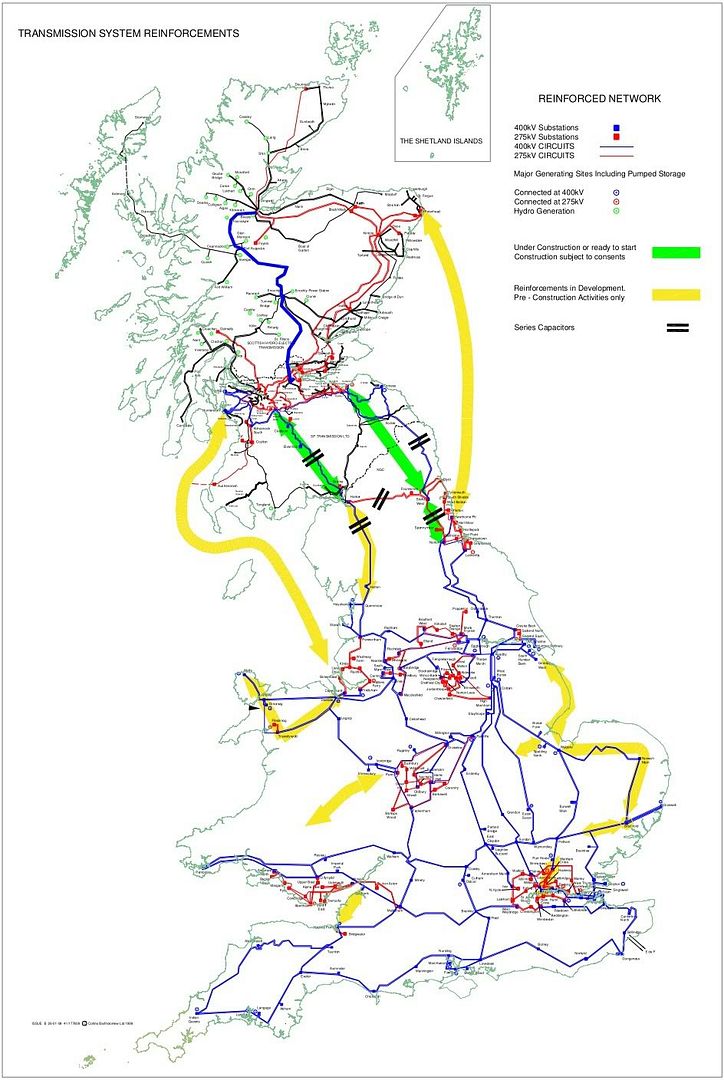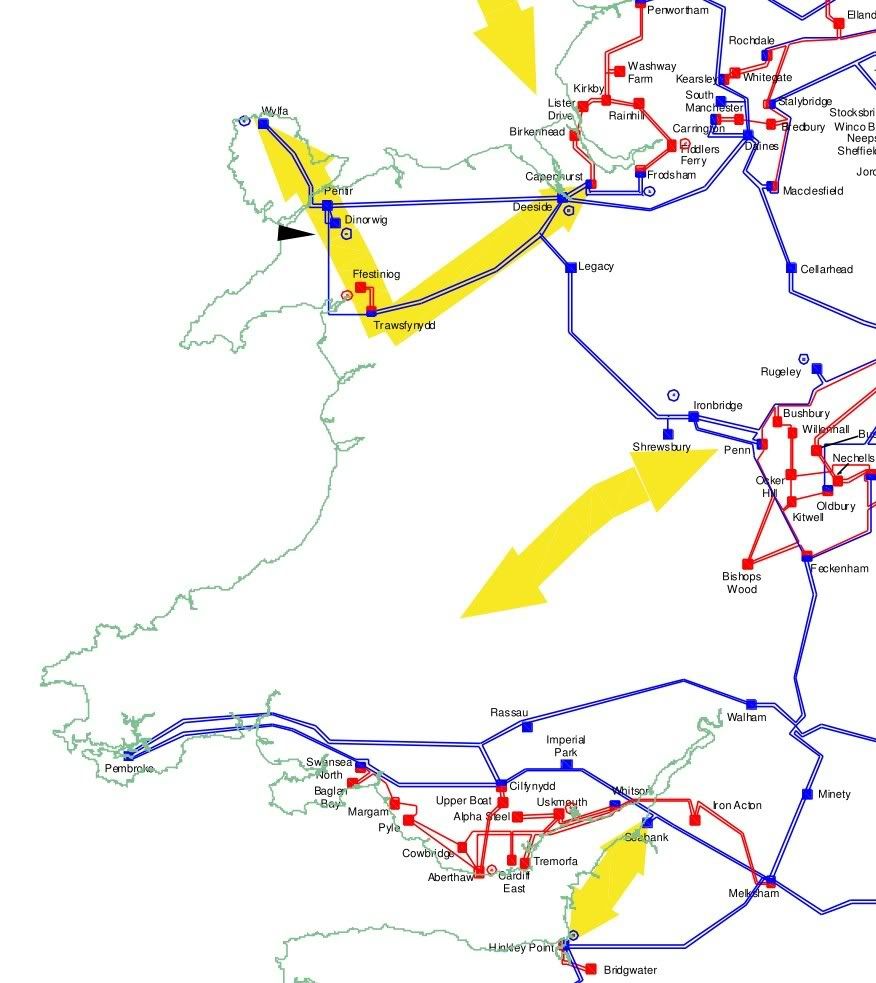There was a story in the Daily Post last a couple of weeks ago that surprised me:
Investigation into giant cable from Anglesey for windfarm power
A £1m study to investigate the viability of laying a giant electricity cable from Anglesey to South West Wales has been launched. The cable system would run from Wylfa down to Pembroke and carry additional energy generated by the planned giant windfarms in the Irish Sea. This would then enter the National Grid in South West Wales, where additional Grid links have been added for the building of Pembroke Power Station.
Ofgem gave the go ahead for the £1m study to start this week. A National Grid source said it may still require a separate power link from a proposed Wylfa B nuclear power station – with that either carried on over-land pylons or an undersea link.
A National Grid spokeswoman said: “This is a long-term study, this cable would potentially take additional capacity from the windfarms planned for the Irish Sea. This would see cables running from Anglesey to Pembroke. This money (£1m) will pay for research into the viability of this option, it is one of the options we are looking at to reinforce the network.”
My surprise was that this was being considered now, because it certainly wasn't part of Ofgem or the National Grid's thinking before. The group that does forward thinking on the way the electricity grid works is the Electricity Networks Strategy Group, and they published this report in 2009:
Our Electricity Transmission Network: A Vision for 2020
This map from the report shows Britain's current electricity transmission grid, together with the reinforcements proposed.
To anyone concerned about Wales, the most obvious thing that stands out is that we have good grid connexions in both north and south, but absolutely nothing in Wales that links north and south. In fact, central Wales is further from the main grid than any other part of this island, even including the more remote parts of the Scottish Highlands.
The broad green and yellow arrows show the grid reinforcements proposed by the ENSG. Their priority has been to strengthen the grid between Scotland and the rest of our Britain. This is because we are generating more electricity from renewables and Scotland has vast renewable resources, particularly wind. This also explains why grid reinforcement is needed along the east coast of England: because there are a number of very large windfarm zones proposed for the North Sea.
However if we focus on Wales, their thinking at the time was rather less developed:
There is just an arrow from the English Midlands to connect to the onshore windfarms in mid Wales. But this would of course do nothing for the electricity infrastructure of Wales, it would primarily export the energy we produce to England.
-
A second factor that effects the equation is the increasing cost effectiveness of undersea HVDC cables. Up until a few years ago, National Grid would only have considered a departure from overhead power lines in very exceptional circumstances. But the first map shows that they are considering two undersea cable routes: one between Scotland and England and one between Scotland and Wales. There are details of the Hunterston to Connah's Quay proposal here, and a series of public meetings to explain the proposal is taking place this week.
It goes without saying that National Grid would not be considering such undersea cables unless they were as cost effective as land-based, overhead power lines on pylons would be. And put into a wider context, undersea HDVC cables are currently proposed or in the process of construction to link Britain and Ireland to continental Europe and Scandinavia, by means of what has been dubbed a Supergrid.
In fact there are currently three proposals to link Wales and Ireland. The more advanced project is the East-West Interconnector by EirGrid, currently under construction and due to be completed by 2012. This will link North Rush, just north of Dublin, with Barkby Beach in Prestatyn.
However I was more interested in two other interconnector projects by Imerapower, which proposed these additional cable routes:

To me, what was much better about the Imerapower proposals is that instead of leaving north and south Wales as two outlying spurs in the electricity grid, it put Wales right in the centre of a much larger British/Irish grid. People can read what I said about it at the time here.
-
The point at issue is simple, and I could do no better than point to what Draig said in another thread at the time.
In Wales the high voltage network is operated by National Grid, and the local distribution network is operated in South Wales by Western Power Distribution, and in N. Wales by Scottish Power Manweb.
What this means is that the grid basically splits Wales in two, and doesn't treat us as a unified entity.
We in South Wales pay amongst the highest electricity cost in the UK (Source: Energywatch) because S. Wales is classed as a "negative transmission zone", which basically means that we import electricity from England.
North Wales exports far more than it consumes, to the big conurbations of the North West of England (those illuminations in Blackpool are powered by North Walian electricity) so when you aggregate the figures, as a whole we are a net exporter.
So the reason we in South Wales pay such high electric bills is because the grid doesn't allow us to use N. Wales surplus. If Wales was served by a single unified grid, our electricity bills would be lower.
In fact people in south Wales pay 10% more for electricity than people in England, and people in north Wales pay 4% more ... or at least that was the position in 2008, according to this report. This illustrates just how much being at the end of two outlying spurs of the grid costs us. For how does it make any economic sense that a net exporter of electricity like Wales pays more for the product it produces than a net consumer?
And on that point it is worth noting that south Wales, two years later, is no longer a net importer of electricity. Now that SevernPower has become fully operational, south Wales produces roughly as much electricity as it consumes. But when the 2,000 MW Pembroke power station comes online, both north and South Wales will be producing far more electricity than we need ... but we will still pay more for it than England.
This is why it is so important that we link north and south Wales directly.
And I have to say that the news brings a quiet smile of satisfaction to my face for a different reason. For when we discussed how best to achieve this link, I said:
Now, thinking about solutions to the problem, I guess the obvious one would be put a major north-south cable alongside/under the A470 as part of that infrastructure upgrade. But it might not be such a crazy idea (and it would be faster and involve much less disruptive work) to run an undersea cable across Cardigan Bay between Gwynedd and Pembrokeshire.
So perhaps I should claim the first chunk of that £1m feasibility study.
-
But I'm much more interested in what's good for Wales as a country. This map illustrates the way the UK grid is divided into distribution networks:

North Wales is part of a distribution area that includes Cheshire and Merseyside; and although the south Wales and south west England areas are separate licence areas, both licences are held by the same company and run as a joint operation from the same head office.
I want to see all matters regarding the generation and transmission of electricity in Wales devolved to Wales. For that to become a practical reality, we need not only licence areas that match our geographical boundaries, but for these licence areas to be directly linked as part of the grid.
So as well as a very good economic reason, there is also a very good political reason why this proposed undersea HVDC cable directly linking north and south is so important to us in Wales.




6 comments:
If Wales is not to become a despoiled landscape covered in pylons carrying electricity piecemeal to England then people need to join the debate on what sort of electricity transmission system we really need. To start vote at www.38degrees.org to put pylons underground.
The Snowdonia Society is running a vigorous campaign to resist any more pylons - or strengthening of existing lines - in the National Park. This might have had an influence - particularly if you consider Boris' quote after £250M was spent placing cables underground in the Olympic Park (at UK bill payer expense): "'For as long as I can remember the first thing that strikes you as you travel further to the east of town are these ugly structures dominating the skyline and blighting the area. Their removal, on time and on budget once again, is the clearest sign yet of how the investment in the Olympics is bringing with it the promised regeneration legacy of the future - freeing up and cleaning up land for development after the Games and putting in first class infrastructure that will all bring new jobs, new homes and new opportunities to people in east London". As I understand it National Grid has been stung into examining the subsea option. (http://www.london2012.com/press/media-releases/2008/11/east-london-skyline-transformed-as-first-olympic-park-pylon-comes-down.php)
Thanks Paul. Just for anyone else, it's 38degrees.org.uk, but I've just looked and couldn't find anything about pylons or the grid. Is there a campaign I've missed, or are you suggesting we should start one?
But one definite advantage of the undersea HVDC cables is that they are invisible, and therefore much better than pylons, especially pylons across mid-Wales.
On an all-island level, I wonder if you've come across this proposal for a "ring main" of undersea HVDC cables?
I'm sure the efforts of the Snowdonia Society will have had an impact, Naturiaethwr. It's hard to think of a landscape that is more worthy of protection.
As for the grid strengthening to and from Wylfa (one route goes via Trawsfynydd) it would have probably been better to run the EirGrid East-West Interconnector in two undersea sections (from Ireland to Wylfa, then from Wylfa to Prestatyn) rather than have to strengthen the existing route.
Hi MH. the link for the 38degrees campaign for undergrounding can be found on www.no-moor-pylons.co.uk. What must not happen is Wales to become a highway for the undersea connectors from Ireland and Wylfa purely to feed the UK and maybe the rest of Europe.The proposal on your comment refers to the Stour Valley Underground team in Suffolk who are campaigning for the undergrounding and subsea route from the offshore wind farms and Sizewell.
Nice information, thanks for sharing in blog post.
VAT Free Zones
Post a Comment